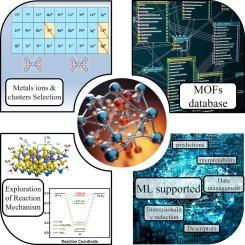Computational design of Metal-Organic Frameworks for sustainable energy and environmental applications: Bridging theory and experiment
IF 3.9
3区 材料科学
Q2 MATERIALS SCIENCE, MULTIDISCIPLINARY
引用次数: 0
Abstract
This review explores the pivotal role of computational approaches in designing and developing Metal-Organic Frameworks (MOFs) for sustainable energy and environmental applications. As demand for advanced materials in energy conversion, storage, and environmental remediation intensifies, the synergy between theoretical simulations and experimental research has become critical. We provide a systematic overview of recent advancements in computational strategies guiding MOF synthesis and optimization, focusing on how these approaches offer insights into MOF mechanisms and working principles. The review examines fundamental computational techniques, including density functional theory, molecular dynamics, and machine learning, exploring their application in predicting and enhancing MOF performance for gas storage, catalysis, and pollutant capture. Through analysis of case studies, we demonstrate how computational modeling has successfully improved MOF performance in real-world scenarios. We also address challenges in bridging theory and experiment, discussing strategies for enhancing model accuracy and applicability.

用于可持续能源和环境应用的金属有机框架的计算设计:连接理论与实验
这篇综述探讨了计算方法在设计和开发用于可持续能源和环境应用的金属有机框架(MOFs)中的关键作用。随着能源转换、储存和环境修复领域对先进材料的需求日益增长,理论模拟与实验研究之间的协同作用变得至关重要。我们系统地综述了指导 MOF 合成和优化的计算策略的最新进展,重点介绍了这些方法如何深入了解 MOF 的机理和工作原理。综述研究了基本计算技术,包括密度泛函理论、分子动力学和机器学习,探讨了这些技术在预测和提高 MOF 在气体储存、催化和污染物捕获方面的性能方面的应用。通过对案例的分析,我们展示了计算建模是如何在现实世界中成功提高 MOF 性能的。我们还探讨了理论与实验之间的挑战,讨论了提高模型准确性和适用性的策略。
本文章由计算机程序翻译,如有差异,请以英文原文为准。
求助全文
约1分钟内获得全文
求助全文
来源期刊

Materials Science and Engineering: B
工程技术-材料科学:综合
CiteScore
5.60
自引率
2.80%
发文量
481
审稿时长
3.5 months
期刊介绍:
The journal provides an international medium for the publication of theoretical and experimental studies and reviews related to the electronic, electrochemical, ionic, magnetic, optical, and biosensing properties of solid state materials in bulk, thin film and particulate forms. Papers dealing with synthesis, processing, characterization, structure, physical properties and computational aspects of nano-crystalline, crystalline, amorphous and glassy forms of ceramics, semiconductors, layered insertion compounds, low-dimensional compounds and systems, fast-ion conductors, polymers and dielectrics are viewed as suitable for publication. Articles focused on nano-structured aspects of these advanced solid-state materials will also be considered suitable.
 求助内容:
求助内容: 应助结果提醒方式:
应助结果提醒方式:


